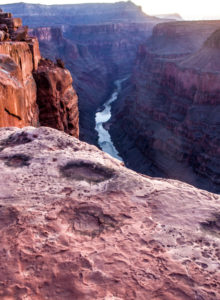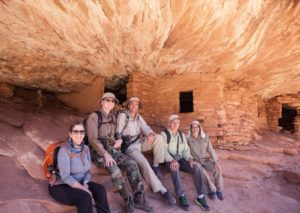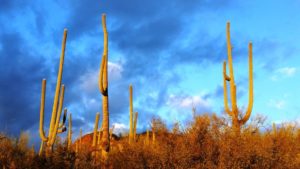
The Grand Canyon taught Mitch a hard-earned lesson in trail guiding.
One of our frequent contributors to clarknorton.com, my friend Mitch Stevens, is kicking off our occasional series of first-person pieces on how various baby boomers got started traveling for a living.
Mitch’s odyssey led him from summer camp in Pennsylvania to the depths of the Grand Canyon to college field trips in Wyoming and eventually to Tucson in the (mostly) sunny deserts of southern Arizona, where’s he’s been leading Sierra Club hikes for years and more recently founded his adventure travel company Southwest Discoveries.
Like the intrepid cyclists who compete in the 100-mile El Tour de Tucson race each fall, Mitch’s long-distance hikes through the canyons and across the mountains of the Southwest provide inspiration to me as I sit here at my computer giving my typing fingers a thorough workout.
So lace up your hiking boots, grab a bottle of water, apply sun protection and follow Mitch on his trails of discovery.
By Mitch Stevens
The young lady started hiking up Grand Canyon’s Bright Angel Trail under a hammering summer sun. Because she was visiting from England she wasn’t used to the desert heat.
A few days earlier, I had cajoled her into hiking to the bottom of the canyon. I was 24, she was 23 and we had met three summers prior at a coed sleep-away camp in upstate New York’s Adirondack Mountains.
But the Southwest U.S. was an entirely different ballgame.
We were two miles above Indian Gardens, the halfway point of the return hike, when a monsoon storm rolled in and the sky opened in a torrential downpour. Soon we experienced thunder, lightning and rocks crashing all around us.
Taking refuge under an overhang, we attempted to wait out the storm. The temperature dropped about 40 degrees in less than 15 minutes and the wind blew hard.
Wearing only light shirt-sleeves, we went from roasting in mid-day heat to shivering in the chill of the storm. But after a brutal ascent, we finally made it up to the rim of the canyon.
Growing Up a City Kid
I grew up in New York City, surrounded by asphalt, concrete, and towering buildings.
But one summer, my parents sent my brother and me away to a summer camp in the woods of Pennsylvania that specialized in backpacking and hiking. That stuck with me: I majored in geology at City College of New York and longed to get back into the outdoors.

Mitch-led hikers at Cedar Mesa, Utah
While working on my degree I got my chance, taking a field trip to the Bighorn Basin, Yellowstone National Park, and the Grand Tetons in Wyoming. After that, I was almost obsessed with the West and its wild-lands.
My next trip was to the Southwest and that sealed the deal. My wife and I decided to move west, and we examined San Diego, Tucson, and Albuquerque as possible home bases.
We settled on Tucson in 1984. The warm climate was really appealing; I was tired of the snow, ice, and gray skies along the eastern seaboard. And there was something about the desert here that fascinated me.
Exploring the Southwest
I began hiking and exploring Arizona and the Southwest.
Eventually, that led me to rejoin Sierra Club, and, in 2006, I began leading hikes for the Club’s Rincon Group, where I met many friendly people who were environmentally minded.
When the Rincon Group Outings Chair position opened in late 2008, I stepped up and took on the task. I now lead about 12 hikes a year while ensuring that the club has an ample stable of outings leaders who meet the necessary qualifications and, with my help, put together appealing hikes for people of all interests and skill levels.
Each year, I organize several long backpacking trips. Recently, I’ve led excursions to spectacular places such as Kanab Creek, the longest tributary to the Colorado River in the Grand Canyon. Our group followed it from the Indian Hollow trail-head to the Colorado, a hike of 55 miles.
Another version of that very popular trip was a nine-day outing that started at Monument Point at the North Rim, descended to Thunder River and Deer Creek, then traversed the Colorado River to Kanab Creek and back to the Rim at Sowats Point.

Blacketts Ridge, Tucson, Arizona
I have also led trips to the Sierra Nevada of California, the San Juan Mountains of Colorado and the canyon country of southern Utah.
Some of my favorite places in the Southwest include the trails of southern Arizona, the Grand Canyon and the canyon country of Utah.
We recently completed a trip to the inner recesses of Canyonlands National Park. Canyonlands is an archeological treasure trove, rich in granaries, ruins and rock art of the ancient Fremont culture. Other places we’ve canvassed include Utah’s Cedar Mesa, Capital Reef National Park and Arizona’s Keet Seel.
Three years ago, we founded Southwest Discoveries – an adventure tour company specializing in fantastically beautiful and secluded places in the southwest. Taking people to the unique and special places that we have discovered makes them more willing and more focused on working, often with the Sierra Club, to protect these areas and to ensure that our nation has solid policies to keep them special. That’s the driving motive that led us to start Southwest Discoveries.
Hiking Tucson
As a Tucson hiking guide, I’ve been privileged to experience some of the most amazing hikes in the Southwest.
In 3 Incredible Hikes in Tucson, we showcase the Blacketts Ridge, Agua Caliente Hill and Wildhorse Canyon trails, all spectacular hikes. Tucson’s trails can be hiked year-round, from the winter warmth of the low desert to the cool pines atop Mount Lemmon in the summer.
The city is surrounded by three distinct sky island ranges, the Santa Catalina, Rincon and Santa Rita mountains. Sky islands are isolated peaks which rise from the desert floor to lofty elevations where plants and animals, left over from the last ice age, can only survive on the mountain tops.
Thunderstorms ring the Tucson Valley most days from early July through mid-September. The Southwest Monsoon, second largest on the planet, creates a web of biodiversity that makes the Sonoran Desert the most bio-diverse desert in the world.
The monsoon not only affects the weather and flora and fauna of southern Arizona but also the Grand Canyon, southern Utah, southwestern Colorado and the Sierra Nevada Mountains of California.












3 Responses to How One Boomer Became a Trail Guide